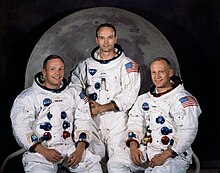
Apollo 11
First crewed Moon landing / From Wikipedia, the free encyclopedia
Dear Wikiwand AI, let's keep it short by simply answering these key questions:
Can you list the top facts and stats about Apollo 11?
Summarize this article for a 10 years old
Apollo 11 (July 16–24, 1969) was the American spaceflight that first landed humans on the Moon. Commander Neil Armstrong and Lunar Module Pilot Buzz Aldrin landed the Apollo Lunar Module Eagle on July 20, 1969, at 20:17 UTC, and Armstrong became the first person to step onto the Moon's surface six hours and 39 minutes later, on July 21 at 02:56 UTC. Aldrin joined him 19 minutes later, and they spent about two and a quarter hours together exploring the site they had named Tranquility Base upon landing. Armstrong and Aldrin collected 47.5 pounds (21.5 kg) of lunar material to bring back to Earth as pilot Michael Collins flew the Command Module Columbia in lunar orbit, and were on the Moon's surface for 21 hours, 36 minutes before lifting off to rejoin Columbia.
 Buzz Aldrin on the Moon in a photograph taken by Neil Armstrong, who can be seen in the visor reflection along with Earth,[1] the Lunar Module Eagle, and the U.S. flag | |
| Mission type | Crewed lunar landing (G) |
|---|---|
| Operator | NASA |
| COSPAR ID |
|
| SATCAT no. | |
| Mission duration | 8 days, 3 hours, 18 minutes, 35 seconds |
| Spacecraft properties | |
| Spacecraft |
|
| Manufacturer |
|
| Launch mass | 109,646 pounds (49,735 kg)[5] |
| Landing mass | 10,873 pounds (4,932 kg) |
| Crew | |
| Crew size | 3 |
| Members | |
| Callsign |
|
| Start of mission | |
| Launch date | July 16, 1969, 13:32:00 (1969-07-16UTC13:32Z) UTC[6] |
| Rocket | Saturn V SA-506 |
| Launch site | Kennedy Space Center LC-39A |
| End of mission | |
| Recovered by | USS Hornet |
| Landing date | July 24, 1969, 16:50:35 (1969-07-24UTC16:50:36Z) UTC |
| Landing site |
|
| Orbital parameters | |
| Reference system | Selenocentric |
| Periselene altitude | 100.9 kilometers (54.5 nmi)[7] |
| Aposelene altitude | 122.4 kilometers (66.1 nmi)[7] |
| Inclination | 1.25 degrees[7] |
| Period | 2 hours[7] |
| Epoch | July 19, 1969, 21:44 UTC[7] |
| Lunar orbiter | |
| Spacecraft component | Command and service module |
| Orbital insertion | July 19, 1969, 17:21:50 UTC[8] |
| Orbital departure | July 22, 1969, 04:55:42 UTC[9] |
| Orbits | 30 |
| Lunar lander | |
| Spacecraft component | Apollo Lunar Module |
| Landing date | July 20, 1969, 20:17:40 UTC[10] |
| Return launch | July 21, 1969, 17:54:00 UTC[11] |
| Landing site | |
| Sample mass | 21.55 kilograms (47.51 lb) |
| Surface EVAs | 1 |
| EVA duration | 2 hours, 31 minutes, 40 seconds |
| Docking with LM | |
| Docking date | July 16, 1969, 16:56:03 UTC[8] |
| Undocking date | July 20, 1969, 17:44:00 UTC[13] |
| Docking with LM ascent stage | |
| Docking date | July 21, 1969, 21:35:00 UTC[9] |
| Undocking date | July 21, 1969, 23:41:31 UTC[9] |

 Left to right: Neil Armstrong, Michael Collins, Buzz Aldrin | |
Apollo 11 was launched by a Saturn V rocket from Kennedy Space Center on Merritt Island, Florida, on July 16 at 13:32 UTC, and it was the fifth crewed mission of NASA's Apollo program. The Apollo spacecraft had three parts: a command module (CM) with a cabin for the three astronauts, the only part that returned to Earth; a service module (SM), which supported the command module with propulsion, electrical power, oxygen, and water; and a lunar module (LM) that had two stages—a descent stage for landing on the Moon and an ascent stage to place the astronauts back into lunar orbit.
After being sent to the Moon by the Saturn V's third stage, the astronauts separated the spacecraft from it and traveled for three days until they entered lunar orbit. Armstrong and Aldrin then moved into Eagle and landed in the Sea of Tranquility on July 20. The astronauts used Eagle's ascent stage to lift off from the lunar surface and rejoin Collins in the command module. They jettisoned Eagle before they performed the maneuvers that propelled Columbia out of the last of its 30 lunar orbits onto a trajectory back to Earth.[9] They returned to Earth and splashed down in the Pacific Ocean on July 24 after more than eight days in space.
Armstrong's first step onto the lunar surface was broadcast on live TV to a worldwide audience. He described the event as "one small step for [a] man, one giant leap for mankind."[lower-alpha 1][15] Apollo 11 effectively proved U.S. victory in the Space Race to demonstrate spaceflight superiority, by fulfilling a national goal proposed in 1961 by President John F. Kennedy, "before this decade is out, of landing a man on the Moon and returning him safely to the Earth."[16]